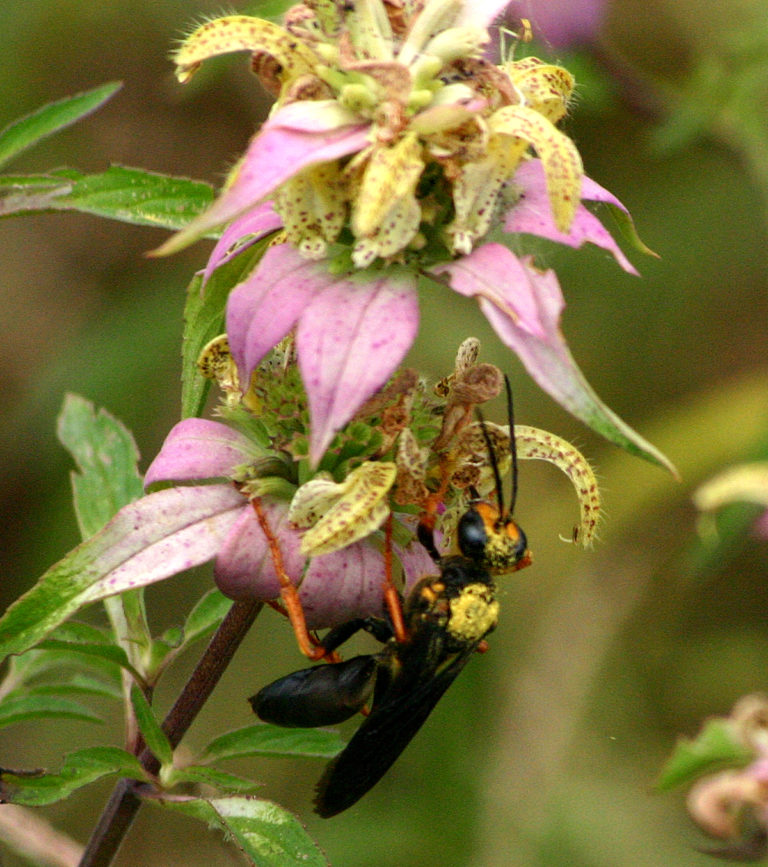Horsemint or Spotted Beebalm is an erect, mostly unbranched, perennial wildflower, instantly recognized by its unusual “stacked” arrangement of multiple whorls of two-lipped, cream-colored, purple-speckled tubular flowers on the same stem. Each whorl is subtended by attractive and persistent pink to lavender leaf-like bracts. Leaves are narrow with a fine grayish-white pubescence and oregano- or thyme-like aroma. Plants occur in disturbed or high quality sandy habitats such as sandy prairies, savannas and sand dunes from Vermont to southeastern Minnesota, south to Florida and Texas, but missing from most of the Ohio drainage. In NC, Spotted Beebalm is found in some mountain counties, piedmont counties, and coastal plain counties. It is considered a short-lived perennial or even a biennial by some internet sources, but not all. It is visited by a great many pollinators, including bees and moths, butterflies, wasps and bugs.
NURSERY HOURS
Wednesday: 10-4 Thursday: 10-6 Friday-Saturday: 10-4 Sunday: 12-4
Monarda punctata

Key Info
Scientific Name: Monarda punctata L.
Common Names: Bee Balm, Dotted Horsemint, Dotted Mint, Spotted Bee balm, Spotted Horsemint
Family Names: Lamiaceae (Mint) Family
Plant Type: Herbaceous perennial
Leaf Retention: Deciduous
Flower Color: The tubular flowers are cream with purple spots; the showy bracts are generally pinkish but may be white or purple.
Additional Info
Habit: The main stem is is brown to reddish purple, unbranched or sparingly so, except for short leafy stems that develop from the axils of the leaves along the central stem. The main stem is square and densely pubescent. The root system consists of a taproot, and this wildflower reproduces by reseeding itself (Illinois Wildflower.org). Others comment that as the plant's shallow root systems spread easily through light soil with a few rhizomes, and multiple stems may arise from this system (Friendsofthewildflowergarden.org).
Height: 1'-3 '
Spread: 1'
Soil Conditions: This plant is found in dry sandy soil Circumneutral (pH 6.8-7.2)
Leaves: The leaves have opposite arrangement, are up to 3½" long and 1" across, medium green, and lanceolate to narrowly lanceolate, with short petioles. The margins of the leaves are usually serrated with low teeth, hairy, with aroma akin to oregano.
Flowers (or reproductive structures: The central stem produces two or more dense whorls of flowers in the upper portion of each plant. The uppermost whorl of flowers is terminal, while the lower whorls of flowers develop from the axils of the upper pairs of leaves. Each flower is about ¾–1" long, consisting of a cream-colored corolla with purple spots and a tubular calyx with 5 triangular teeth.Underneath each whorl of flowers, there are several pink or lavender (light green beneath) leafy bracts. The blooming period occurs from mid-summer to early fall and lasts about 1-2 months. While individual corollas soon wither away, the showy bracts remain attractive for a long time afterward. (Illinois Wildflowers.info)
Fruit: Each flower is replaced by 4 small nutlets, which are ovoid and smooth.
Natural Distribution: This species can be found in both disturbed and higher quality sandy habitats: prairies, especially sand prairies, plains, meadows, pastures, savannas, stabilized sand dunes and sandy fields.
USDA Hardiness Zone: 4-9
USDA Wetland Indicator Status in NC: FACU (Atlantic & Gulf coastal plain) UPL (Eastern mts & piedmont)
Pollination: Insect pollinated.
Wildlife Connections: The nectar and pollen of the flowers attract many bees and butterflies; moth caterpillars feed on the flowers, foliage or stems as well as beetles and bugs. The oregano-scented foliage is repugnant to mammalian herbivores and rarely consumed by them. See Illinois Wildflowers.org. Monarda support the following specialized bees: Dufourea monardae, Perdita (Perdita) gerhardi, and Protandrena abdominalis. This is a host plant for the Gray Marvel Moth, Anterastria teratophora, and the Snout Moth, Pyrausta generosa, P. signatalis. See NC State Extension
Propagation: Root cutting or seed
